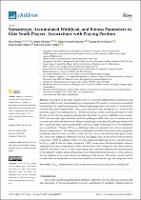Por favor, use este identificador para citar o enlazar este ítem:
https://repositorio.usj.es/handle/123456789/611
| Título : | Somatotype, accumulated workload, and fitness parameters in elite youth players: Associations with playing position |
| Autor: | Nobari, Hadi



Oliveira, Rafael 
Clemente, Filipe Manuel 

Pérez-Gómez, Jorge 


Mainer Pardos, Elena 


Ardigò, Luca Paolo 

|
| Palabras clave : | VO2max; Anthropometric; Body composition; Maturation; Peak power; Training load |
| Fecha de publicación: | 10-may-2021 |
| Editorial : | MDPI |
| Citación : | Nobari, H.; Oliveira, R.; Clemente, F.M.; Pérez-Gómez, J.; Pardos-Mainer, E.; Ardigò, L.P. Somatotype, Accumulated Workload, and Fitness Parameters in Elite Youth Players: Associations with Playing Position. Children 2021, 8, 375. https://doi.org/10.3390/children 8050375 |
| Resumen : | The purpose of this study was three-fold: (1) to describe anthropometric, maturation, and somatotype differences of players based on playing positions; (2) to analyze variations of accumulated load training (AcL) and fitness parameters between playing positions; and finally (3) to explain the variation of maximal oxygen uptake (VO2max) and peak power (PP) through the AcL, body fat (BF), maturity, somatotype and fitness levels. Twenty-seven male youth soccer players under-16 were divided by the following positions participated in this study: six central midfielders, four wingers (WG), five forwards, eight defenders, and four goalkeepers (GK). They were evaluated on two occasions: pre-season and after-season. Height, sitting height, body mass, BF, girths, percentage of BF (BF%), lean body mass, maturity, somatotype, sprint test, change of direction test, Yo-Yo intermittent recovery test level 1, Wingate, PP, VO2max and fatigue index were assessed. Then, AcL was monitored during training sessions. The main results revealed significant differences between player positions for maturity offset (p = 0.001), for BF (p = 0.006), BF% (p = 0.015), and lean body mass kg (p = 0.003). Also, there were significant differences for AcL and fatigue index in pre-season between player positions (p < 0.05). In addition, there were some significant differences in pre- and after-season for VO2max and PP between player positions (p < 0.05). In conclusion, GK showed higher values in anthropometric, body composition variables and maturity offset compared to the other positions, while WG presented lower levels of BF. In pre-season, there were more differences by player positions for the different variables analyzed than after-season that reinforces the tactical role of the positions, and the emphasis in increased load in the beginning of the season. This study could be used by coaches, staff, and researchers as a reference for athletes of the same sex, age, and competitive level. |
| URI : | https://repositorio.usj.es/handle/123456789/611 |
| ISSN : | 2227-9067 |
| Aparece en las colecciones: | Artículos de revistas |
Ficheros en este ítem:
| Fichero | Descripción | Tamaño | Formato | |
|---|---|---|---|---|
| Somatotype, Accumulated Workload, and Fitness Parameters.pdf | 1,15 MB | Adobe PDF |  Visualizar/Abrir |
Este ítem está sujeto a una licencia Creative Commons Licencia Creative Commons

